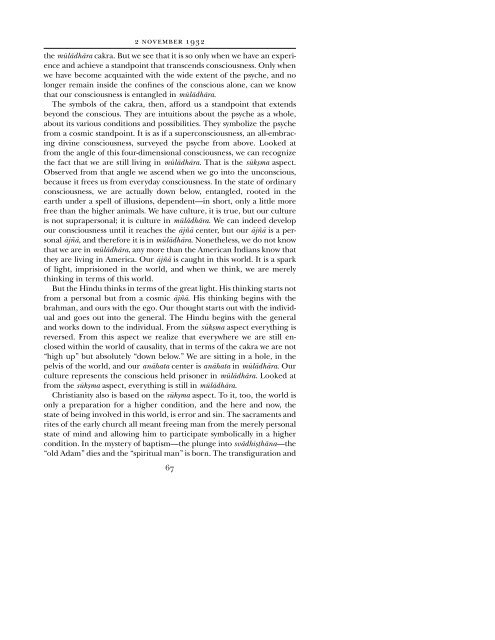CG JUNG - Countryside Anarchist
CG JUNG - Countryside Anarchist
CG JUNG - Countryside Anarchist
You also want an ePaper? Increase the reach of your titles
YUMPU automatically turns print PDFs into web optimized ePapers that Google loves.
2 NOVEMBER 1932<br />
the mÖlvdhvra cakra. But we see that it is so only when we have an experience<br />
and achieve a standpoint that transcends consciousness. Only when<br />
we have become acquainted with the wide extent of the psyche, and no<br />
longer remain inside the confines of the conscious alone, can we know<br />
that our consciousness is entangled in mÖlvdhvra.<br />
The symbols of the cakra, then, afford us a standpoint that extends<br />
beyond the conscious. They are intuitions about the psyche as a whole,<br />
about its various conditions and possibilities. They symbolize the psyche<br />
from a cosmic standpoint. It is as if a superconsciousness, an all-embracing<br />
divine consciousness, surveyed the psyche from above. Looked at<br />
from the angle of this four-dimensional consciousness, we can recognize<br />
the fact that we are still living in mÖlvdhvra. ThatisthesÖküma aspect.<br />
Observed from that angle we ascend when we go into the unconscious,<br />
because it frees us from everyday consciousness. In the state of ordinary<br />
consciousness, we are actually down below, entangled, rooted in the<br />
earth under a spell of illusions, dependent—in short, only a little more<br />
free than the higher animals. We have culture, it is true, but our culture<br />
is not suprapersonal; it is culture in mÖlvdhvra. We can indeed develop<br />
our consciousness until it reaches the vjñv center, but our vjñv is a personal<br />
vjñv, and therefore it is in mÖlvdhvra. Nonetheless, we do not know<br />
that we are in mÖlvdhvra, any more than the American Indians know that<br />
they are living in America. Our vjñv is caught in this world. It is a spark<br />
of light, imprisioned in the world, and when we think, we are merely<br />
thinking in terms of this world.<br />
But the Hindu thinks in terms of the great light. His thinking starts not<br />
from a personal but from a cosmic vjñv. His thinking begins with the<br />
brahman, and ours with the ego. Our thought starts out with the individual<br />
and goes out into the general. The Hindu begins with the general<br />
and works down to the individual. From the sÖküma aspect everything is<br />
reversed. From this aspect we realize that everywhere we are still enclosed<br />
within the world of causality, that in terms of the cakra we are not<br />
“high up” but absolutely “down below.” We are sitting in a hole, in the<br />
pelvis of the world, and our anvhata center is anvhata in mÖlvdhvra. Our<br />
culture represents the conscious held prisoner in mÖlvdhvra. Looked at<br />
from the sÖküma aspect, everything is still in mÖlvdhvra.<br />
Christianity also is based on the sÖküma aspect. To it, too, the world is<br />
only a preparation for a higher condition, and the here and now, the<br />
state of being involved in this world, is error and sin. The sacraments and<br />
rites of the early church all meant freeing man from the merely personal<br />
state of mind and allowing him to participate symbolically in a higher<br />
condition. In the mystery of baptism—the plunge into svvdhiü°hvna—the<br />
“old Adam” dies and the “spiritual man” is born. The transfiguration and<br />
67


